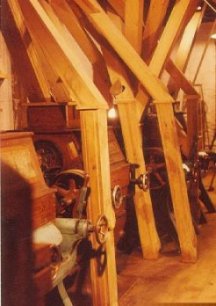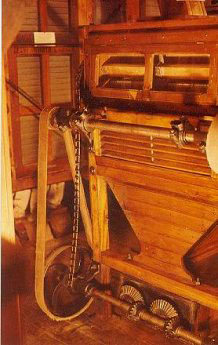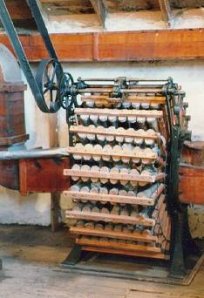
Online Tour
Page 2

CLEVELAND MILLFEST 2013 AT CLEVELAND ROLLER
MILL MUSEUM
Date: Saturday (August 31)
& Sunday (September 1) - Schedule
 |
The wheat seed would begin the grinding
process by going through the first of the roller mill stands
(left). This mill stand contained the "break"
rolls (very rough) that would start the grinding process by "breaking"
the bran outer hull of the wheat and subsequent smoother rolls
would continue the grinding until all possible flour, bran, and
germ was extracted. The long vertical wooden items in the
foreground are gravity chutes, part of the semi-automatic transport
system used to move wheat and flour around the mill. Elevators,
consisting of continuous looped belts with small buckets, would
dump the product into the gravity chute, where it would slide
down to the next machine or bin. |
| The box like object in the background
is one of the huge sifters of the "four box sifter"
and contains large horizontal screens from top to bottom.
The boxes are suspended from an eccentric shaft and the motion
of the shaft when operating, causes the boxes to shake and sift
flour through their screens. The lower half of each box
contains controls to allow flour to cross the screens or bypass
them in order to process the specific grade of flour the miller
wanted. The machine in the foreground is a "plan sifter"
which, besides sifting, also contains a fan to blow off fine
dust. Some of the original belts used to run the mills
machines were made of leather and the museum still maintains
those leather belts that were left on the machines when the mill
ceased operating. |
 |
 |
A strange looking machine indeed.
The sock duster had one duty only, to collect dust. Fine dust
from flour milling can be very hazardous, not only to the health
of people breathing it (it was common for early millers to have
lung congestion), but also because in quantity, dust is a deadly
explosive. Attached to the horizontal piece of wood on
each row was a series of eight cone shaped socks. Dust
was blown into the machine by the two shafts, one on each side
of the duster, and the small metal pipe on the left. The
dust would be trapped in the socks and then later extracted in
bulk and removed. |
| Back
| Home |
Copyright 2013 Historic
Mora Valley Foundation
|

